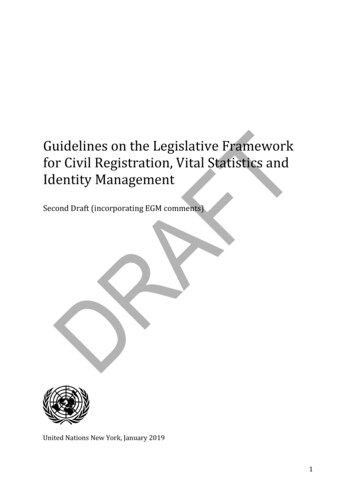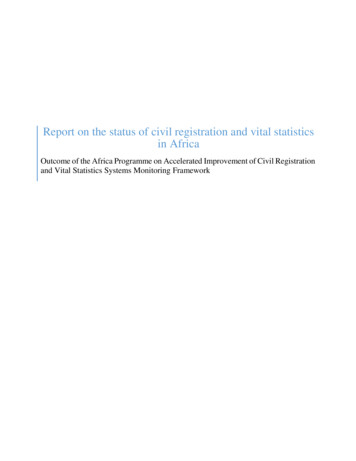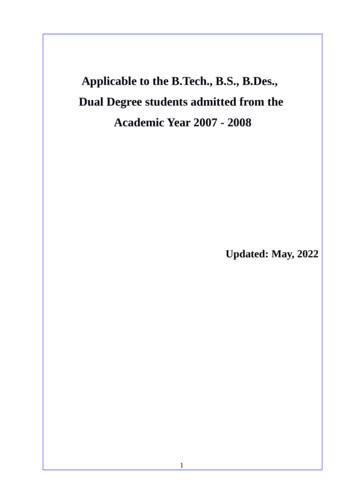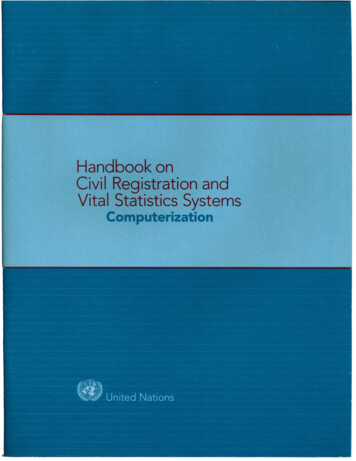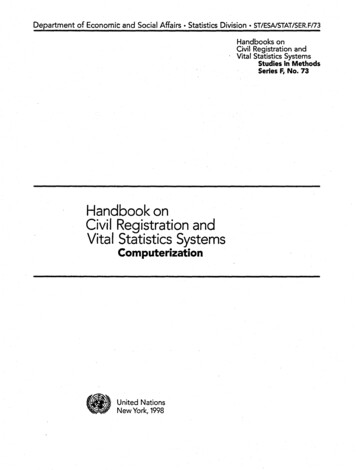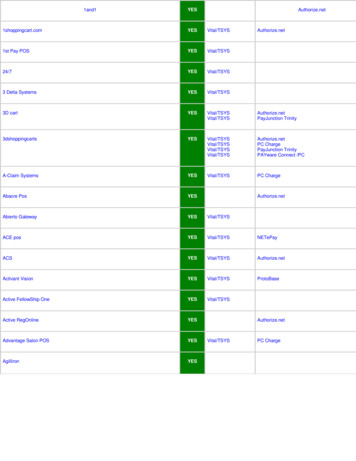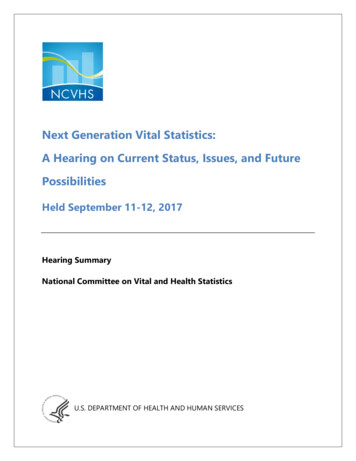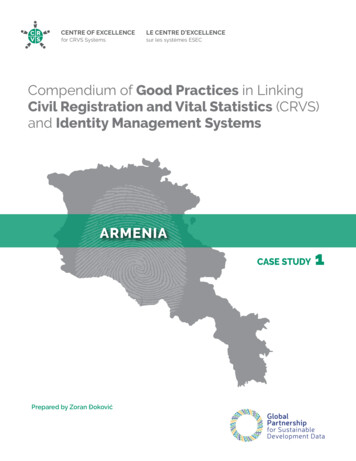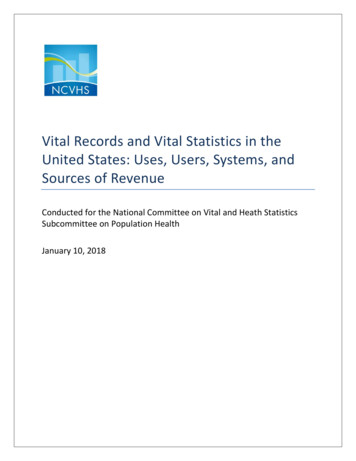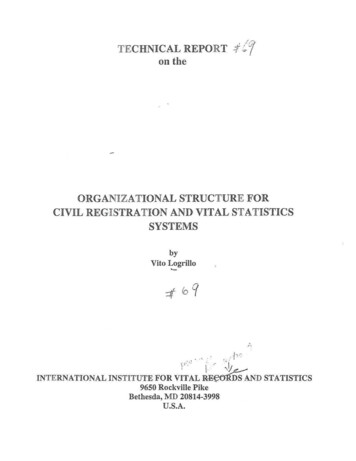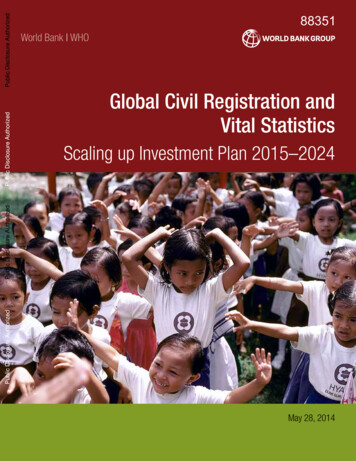
Transcription
Public Disclosure AuthorizedWorld Bank WHOGlobal Civil Registration andVital StatisticsScaling up Investment Plan 2015–2024Public Disclosure AuthorizedPublic Disclosure AuthorizedPublic Disclosure Authorized88351May 28, 2014
Global Civil Registration andVital StatisticsScaling up Investment Plan2015–2024May 28, 2014World Bank WHO
AcknowledgementsThis Global Scaling Up Investment Plan was prepared by the World Bank Group and the WorldHealth Organization with input from severalagencies and countries. The UN Economic Commission for Africa (UNECA), WHO, and the World Bankco-hosted a global consultative meeting on Civil Registration And Vital Statistics (CRVS) in Addis Ababa onApril 28–29, 2014 to discuss and obtain input on a draftinvestment plan. The following agencies, together withexperts in the field of CRVS, contributed to the investment plan through participation in the consultation1 orby providing separate contributions:The Canadian Department of Foreign Affairs, Trade andDevelopment is gratefully acknowledged for the financialsupport it provided in developing the Global CRVS Scaling Up Investment Plan 2015–2024.Overall guidance was provided by Timothy Evans (Senior Director, Health, Nutrition, and Population), Nicole Klingen (Sector Manager, Health, Nutrition, andPopulation) and Haishan Fu (Director, DECDG). The1A list of participants is provided in Annex 9.African Development Bank (AfDB)Partnerships in Statistics for Development in the 21st Century (PARIS21)African Union Commission (AUC)Plan InternationalAsian Development Bank (ADB)Secretariat of the Pacific CommunityBill and Melinda Gates Foundation (BMGF)Statistics NorwayCambridge Economic Policy Associates (CEPA)United States Agency for International Development (USAID)Canadian Department of Foreign Affairs, Trade and Development (DFATD)United Nations Economic Commission for Africa (UNECA)Centers For Disease Control and Prevention (CDC)United Nations Economic and Social Commission for Asia and The Pacific(ESCAP)Center for Global Development (CGD)United Nations Economic and Social Commission For Western Asia(ESCWA)Inter-American Development Bank (IDB)United Nations Every Woman and Every ChildGovernment Representatives and Experts from:United Nations High Commissioner for Refugees (UNHCR) BangladeshUnited Nations Children’s Fund (UNICEF) Burkina FasoUnited Nations Statistics Division (UNSD) EthiopiaUnited Nations Population Fund (UNFPA) MozambiqueWorld Health Organization (WHO) PhilippinesWorld BankOpen Data Watch
ivCRVS Scaling-up Investment Plan 2015–2024World Bank’s CRVS Working Group was led by SamuelMills (Senior Health Specialist, HDNHE) and composedof Amparo Gordillo-Tobar (Senior Economist, LCSHH),Ana Milena Aguilar Rivera (Health Economist, HDNHE), Bob Fryatt (Consultant, HDNHE), David Satola(Lead Counsel, ICOIO), François Marius Lefebvre (Senior Financial Officer, CFPMI), James Neumann (Senior Counsel, LEGPS), Mariana Dahan (Consultant,TWICT), Miyuki Parris (Operations Analyst, HDNHE),Robert Palacios (Team Leader, HDNSP), Samia Melhem(Lead Policy Specialist, Transform Practice, TWICT),and Victoriano Arias (Program Assistant, HDNHE).Several World Bank management and staff provided invaluable inputs. The WHO team comprised Ties Boerma(Director, Department of Health Statistics and Information Systems) and Anneke Schmider (Technical OfficerCRVS, Health Statistics and Information Systems).The findings, interpretations, and conclusions expressedin this Global CRVS Scaling Up Investment Plan donot necessarily reflect the views of the Executive Directors of the World Bank or the governments they represent. The World Bank does not guarantee the accuracyof the data included in this work. the boundaries, colors, denominations, and other information shown onany map in this work do not imply any judgment onthe part of the World Bank concerning the legal statusof any territory or the endorsement or acceptance ofsuch boundaries. For more information contact, Samuel Mills, email: smills@worldbank.org. The full Global CRVS Scaling Up Plan is available on the followingwebsite: ing-up-investment
Table of ContentsAcknowledgements iiiAcronyms ixOverview xiSection 1: The Strategic Case 1What is Civil Registration and Vital Statistics (CRVS)? 1Why does CRVS matter? 2Identification 2Health information and vital statistics 2Birth registration 2Registration of death and cause of death 3Why CRVS will matter even more in the future 3The “Grand Convergence” in health 3Gender dimensions of civil registration and identification 4Civil registration and data in times of crisis 4Harnessing new technology 4Section 2: The Poor Performance of National CRVS Systems 7Current state of CRVS 7Birth registration 7Death and cause of death 7Why are CRVS systems in such poor shape? 8Demand-side: lack of awareness and barriers to registration 8Supply-side problems and the CRVS “ orphan” 8Lack of integration and coordination 9What progress has been made to strengthen CRVS? 10Success stories 10Public-private collaborations 10Statistical capacity 11Privacy and personal information 11
viCRVS Scaling-up Investment Plan 2015–2024Section 3: The Opportunity to Transform CRVS 13Start with women and children 13Registration through maternal, newborn, and child health (MNCH) services 13Harness the data revolution 14Build on regional leadership and global coordination 15African Program for Accelerated Improvement of CRVS (APAI-CRVS) 15Regional initiative to improve CRVS in Asia and the Pacific 15Eastern Mediterranean Regional Strategy for the improvement of civil registrationand vital statistics systems 15Pan-American Health Organization Regional Plan of Action for Strengthening Vitaland Health Statistics 15Global coordination 16Key enabling factors for effective CRVS systems 16CRVS as a public good 16Unique identifiers 16Information Communication Technology 17Enterprise architecture design 17ICT governance 18Mobile technologies 18Incentives mechanisms 18Synergies with identification and e-Governance initiatives 18Section 4: The Scaling Up Plan 19What will it take to deliver? 19National CRVS strengthening 19International support for CRVS 20Sharing knowledge and building the evidence base 21Financing needs 22Costing 22Resource mobilization for CRVS 23Financing mechanisms 24Option 1: Expand scope of existing funding mechanisms 24Option 2: Multi-donor trust fund to leverage IDA/IBRD funding for lending operations 24Option 3: Global Civil Registration and Vital Statistics Program 25What will be delivered and when 25Goal and targets 25Indicators 25Implementation 26Monitoring and evaluation 27Risk and risk mitigation 27
Table of ContentsAnnexesAnnex 1. United Nations Definition of Vital Events 31Annex 2. Status of CRVS Maternal Death Estimates, Birth, Deaths, Quality ofCause-of-Death Reporting 33Annex 3. Country Case Studies 37Annex 4. National Statistical Capacity using World Bank Composite Indicator 49Annex 5. Legal and Regulatory Issues for CRVS 51Annex 6. Status of CRVS in 75 Countries Prioritized by the Commission on Informationand Accountability 55Annex 7. Global CRVS Group Terms of Reference 59Annex 8. Costing of CRVS Scaling Up Plan 61Annex 9. Participants at Global CRVS Consultation in Addis Ababa April 28–29, 2014 67References 71List of FiguresFigure 1. The CRVS systems 1Figure 2. Estimated and reported deaths by income group, 2009 8Figure 3. Brazil – Trends in birth registration 10Figure 4. South Africa – Trends in birth registration 10Figure 5. Birth registration – Compared to antenatal care and DPT1 immunization 13Figure 6. CRVS enterprise architecture design 17Figure 7. Total CRVS development cost per five-year country plan 22Figure 8. Per capita and per vital event CRVS development costs 22Figure 9. Country readiness for implementation 27List of TablesTable 1. Estimated financing gap for 2015–2024 scaling upinvestment plan 23Table 2. Estimation of global CRVS development and recurrent costsfor 73 COIA priority countries 2015–2024a 64Table 3. Main assumptions made to derive per-capita cost per activity in estimating globalCRVS development and recurrent costs for 73 COIA priority countries 2015–2024 65Table 4. Costs of developing CRVS and estimated investment gap CRVS(73 countries) 2015–2024 66List of BoxesBox 1 Country investment plans: Quotes from country stakeholders 37Box 2 Lessons learned from establishing CRVS in Central and South America 38Box 3 E-Governance and birth registration in Cape Verde 39vii
viiiCRVS Scaling-up Investment Plan 2015–2024Box 4 Traditional leaders and birth registration in Senegal 40Box 5 Online and offline mobile birth registration in Uganda 41Box 6 Modernizing the civil register in Albania 42Box 7 Community health workers and birth registration in Bangladesh 43Box 8 Automated Verbal Autopsies in the community in South Africa,Malawi, India, and Nepal 44Box 9 Improving hospital mortality data in Mozambique 45Box 10 Civil register links with maternal and child events in Philippines 46Box 11 Strengthening vital statistics through inter-institutional efforts in Nicaragua 47
RVSPHMISHMNICDICTAsian Development BankAfrican Development BankAfrica Programme on AcceleratedImprovement of Civil Registrationand Vital StatisticsBarangay Civil Registration SystemCommission on Information andAccountability for Maternal andChild HealthCivil Population RegistryCivil Registration and Vital StatisticsEastern Mediterranean RegionalOffice of the World HealthOrganizationUnited Nations Economic andSocial Commission for Asia and thePacificGlobal Civil Registration and VitalStatistics ProgramHealth Management InformationSystemsHealth Metrics NetworkInternational Classification ofDiseasesInformation and formation EducationCommunicationIndependent Expert Review GroupLocal Government UnitsMillennium Development GoalMaternal Newborn Child HealthMaternal Mortality EstimationInter-agency GroupMaternal Death Surveillance andResponseNational Identity SystemsNational Statistical OfficeOrganization of American StatesPartnerships in Statistics forDevelopment in the 21st CenturyPersonal Identification NumberTrust Fund for Statistical CapacityBuildingUnited Nations EconomicCommission for AfricaUnited Nations Population FundUnited Nations Children’s FundVerbal AutopsyWorld Health OrganizationWatching Over Mothers and Babies
OverviewWhat is Civil Registration andVital Statistics?Civil registration is defined by the United Nations as the“Universal, continuous, permanent and compulsory recording of vital events provided through decree or regulation inaccordance with the legal requirements of each country.”(UNSD). It is the act of recording and documenting ofvital events in a person’s life (including birth, marriage,divorce, adoption, and death) and is a fundamental function of governments.Why does CRVS matter?The civil registry provides individuals with the documentary evidence required to secure recognition of their legalidentity, their family relationships, their nationality andtheir ensuing rights, such as to social protection and inheritance. It can help facilitate access to essential services,such as health, education, and social welfare and cancontribute to activities such as gaining formal employment, exercising electoral rights, transferring property,and opening bank accounts. The lack of civil registrationduring crisis or natural disasters can lead to statelessness.The arrival of new technology in resource-constrainedenvironments has created opportunities for developingmore efficient information systems.Unlike other sources of vital statistics, such as censusesand household surveys, the data from Civil Registrationand Vital Statistics (CRVS) systems permit the production of statistics on population dynamics, health, andinequities in service delivery on a continuous basis forthe country as a whole and for local administrative subdivisions. This provides more accurate information and the‘denominator’ for assessing progress with plans across sectors for improving economic growth and reducing poverty. Accurate vital statistics and the ability to monitorand respond to causes of death and disability underpinmany global targets, including new commitments to universal health coverage and tackling the global epidemic ofnon-communicable diseases.Birth registration helps with the identification of population health needs. Birth registration should take place“immediately” following birth, the standard measure being within 30 days of birth. The move to high coveragehealth services for mothers and children makes universalbirth registration at or shortly after birth a realistic goal.It is also central to global efforts aimed at improving earlychildhood development.Death registration provides legal rights to the family,for example, in conferring property or other individualor personal transfer rights to remaining family members.Cause of death registration provides critical informationfor health and development planning to improve the survival of children and adults. A current example of weakCRVS systems is the lack of credible and coherent maternal mortality statistics in areas where mortality is highest.Marriage and divorce registration is a largely unrecognized part of well-developed CRVS systems. Having goodmarriage and divorce registration are frequently requiredto obtain documents that can contribute to women’s ability to inherit property and register their children in somecountries, among other benefits. Registering girls at birth
xiiCRVS Scaling-up Investment Plan 2015–2024and recording their marriages provides a legal backingagainst early and forced marriage.What progress has been made tostrengthen CRVS systems?Current state of CRVSSome countries have seen remarkable improvements inCRVS systems in recent years, for example Brazil andSouth Africa. Good progress has been made in LatinAmerica and regional leadership is now showing progress in Asia and Africa. The private sector has had a major role to play in providing new solutions to improvingaccess to and use of the CRVS system and for providingservices. There has been significant progress in the number of countries that now have National Strategies forthe Development of Statistics. There has also been considerable learning on the need for secure and confidential sharing of personal information across governmentagencies.In the past 10 years, there has been an overall increase inglobal birth registration rates of children under five from58 percent to 65 percent. However, more than 100 developing countries still do not have functioning systemsthat can support efficient registration of births and otherlife events like marriages and death. Around the world,almost 230 million children under the age of five are notregistered. Sub-Saharan Africa is home to 85 million ofthese children, while 135 million live in Asia and the Pacific. Monitoring of data on birth registration rates forchildren under five is no longer considered useful andindicators are now required that help protect the rightsof newborn children. This is an urgent area for consensusbuilding, starting with routine monitoring of birth registration rates within a year of birth. Progress with deathregistration has been much slower globally. In countriesin most need of CRVS, up to 80 percent of deaths thatoccur outside of health facilities and two-thirds of alldeaths globally are not counted.Why are CRVS systems in suchpoor state?Many people are not aware of the importance of birthand death registration for them and their families and theimplications that this has for access to core governmentservices. In some countries, there are discriminatory laws,practices, and attitudes that prevent birth registration.Simplifying the process and providing a vital event registration service within the existing structures with whichcitizens interact can help to dramatically increase registration coverage. Lack of a political priority has resulted inpoorly managed, underfunded CRVS systems, deficientin full-time professional staff. Getting the civil registry,health and vital statistics systems to interact efficiently isa technical challenge requiring standards, protocols, dataexchange, and institutional agreements across many government departments. Modern technology has only progressed piecemeal in many countries and there has beena proliferation of independent databases capturing different information about citizen records.The opportunity to transformCRVSStart with women and childrenThere is now an opportunity to overcome the many deficiencies in the CRVS system through global attentionto improving the health of women and children. Scaledup coverage of maternal, newborn, and child health(MNCH) services, combined with the introductionof new technology, is providing many opportunitiesfor strengthening CRVS, as illustrated by many pilotprograms globally. Maternal and child health servicescan be used as entry points to boost birth registration,such as by creating awareness among pregnant womenduring antenatal care, immediate birth registration ofall institutional births, and ensuring all children whoare vaccinated at six weeks for DTP1 are registered.National commitments to developing Early ChildhoodDevelopment services and registration at centers in ornear schools will be used for “mopping up” those notregistered at birth.Harness the data revolutionThe full value of data from civil registries comes when theyare properly integrated within government systems – forexample with the statistical institutions, population registers, national ID systems, and voter registration systems.
OverviewThere are now opportunities to do this through 21st century CRVS systems that draw on the wide availability ofinformation and communication technology (ICT) andinnovations linking health records with civil registries.New internationally applicable CRVS standards are required for the use of unique identifiers, interoperabilityof information systems, and the various tools and devicesused to collect and transmit data.The Scaling Up PlanWhat it will take to deliverThe global plan has three key components: Build on regional leadership and globalcoordinationRecent years have seen the start of important regional initiatives aimed at strengthening CRVS systems in countries. These provide essential advocacy and accountabilityfor change and create mechanisms to exchange and sharetechnical knowledge and expertise. A global coordinationgroup has recently been established.Key enabling factors for effective CRVSsystemsCRVS is more than the sum of its parts, and its development requires a holistic approach, taking into consideration all events (including births, marriages, deaths, causeof death, and issuing IDs), their supporting informationsystems, and associated legislation. The goal should be tohave one master CRVS system from which data can beaccessed for different purposes while ensuring confidentiality and security.Information Communication TechnologyWell-functioning ICT infrastructure, including a reliable power source, internet, and cell phone coverage,provides the enabling environment for developingmodern CRVS systems, which in turn provides theplatform for interoperable CRVS information systemsand databases. While ICT is not a silver bullet, it canprovide a means to collect, store and retrieve data ina fast, cost-efficient and user friendly way. Recent advances have been made in areas such as enterprise architecture design and mobile technologies and manysynergies can be found with ongoing efforts such asfor strengthening national identification systems (NIS)and voter registration. National CRVS strengthening: removing the barriersto birth registration, improving reporting of deathsand determining cause of death, strengtheningCRVS institutions and ICT systems, strengtheningnational ID mechanisms, and improving the response to deaths and vital statistics.International support for CRVS: This will focus onstrengthening international standards for CRVS,and preparing and sharing guidance based on country experience.Sharing knowledge and building the evidence base:Analysis of barriers and programs of implementation research, together with rigorous impact evaluation, will share lessons on what works in differentsituations.Financing needsThe costs in a number of recent country CRVS investment plans have been employed to estimate the additional financial resources needed to strengthen CRVS in thepriority countries involved in the United Nations Commission on Information and Accountability on Women’sand Children’s Health.The total cost of scaling up and sustaining CRVS systemsin the 73 countries is in the order of US 3.82 billion.This excludes India and China, as their size requires separate analysis. After excluding estimated domestic sourcesof funds, there is an estimated US 1.99 billion financinggap for the global scale-up plan over a ten-year period, oran average of US 199 million financing gap per yearfor 73 countries.Financing mechanismsThe key to success for establishing CRVS systems is strongnational leadership overseeing a country-led plan. Thecriteria for assessing the readiness of countries for international support will include completed comprehensiveassessments; multisectoral costed CRVS plans includin
The arrival of new technology in resource-constrained environments has created opportunities for developing more efficient information systems. Unlike other sources of vital statistics, such as censuses and household surveys, the data from Civil Registration and Vital Statistics (CRVS) systems permit the produc-
